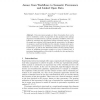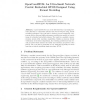875 search results - page 2 / 175 » Representing distributed systems using the Open Provenance M... |
IPAW
2010
13 years 2 months ago
2010
Data provenance graphs are form of metadata that can be used to establish a variety of properties of data products that undergo sequences of transformations, typically specified as...
SDL
2007
13 years 6 months ago
2007
Abstract. OpenComRTOS is one of the few Real-Time Operating Systems (RTOS) for embedded systems that was developed using formal modeling techniques. The goal was to obtain a proven...
ECTEL
2010
Springer
13 years 2 months ago
2010
Springer
In this article we present an infrastructure for creating mash up and visual representations of the user profile that combine data from different sources. We explored this approach...
DEBU
2010
13 years 2 months ago
2010
Sharing structured data today requires agreeing on a standard schema, then mapping and cleaning all of the data to achieve a single queriable mediated instance. However, for setti...
BMCBI
2004
13 years 4 months ago
2004
Background: Hidden Markov Models (HMMs) have proven very useful in computational biology for such applications as sequence pattern matching, gene-finding, and structure prediction...


